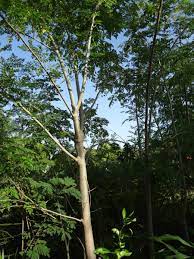Moringa, also known as Moringa oleifera, is a plant that is often referred to as the “drumstick tree” or “horseradish tree.” It is native to parts of Africa and Asia and is known for its highly nutritious leaves, seeds, and pods. Moringa plants have axillary buds, just like many other plants.
Axillary buds are small, dormant buds that are found in the leaf axils of a plant. The leaf axil is the angle or joint between a leaf and the stem from which it grows. Axillary buds can develop into various structures, including new branches, leaves, flowers, or other plant organs. They play a crucial role in the growth and development of the plant.
In the case of Moringa, the axillary buds can give rise to new branches, leaves, and flowers. Proper pruning and care of Moringa plants can help manage their growth and encourage them to produce more leaves and, if desired, more flowers for seeds.
The Economic Importance and Uses of Moringa Axillary buds

Moringa, also known as Moringa oleifera, is a versatile plant with a wide range of economic and practical uses. While axillary buds specifically may not be a primary focus, various parts of the Moringa plant, including leaves, seeds, and roots, offer numerous economic benefits.
Here are some of the economic importance and uses of Moringa:
1. Nutrient-Rich Leaves: Moringa leaves are highly nutritious and are used as a food source in many regions. They are rich in essential vitamins and minerals, making them an important source of nutrition, particularly in areas with food scarcity.
2. Medicinal Properties: Moringa leaves, bark, and roots are known to have medicinal properties. They are used in traditional medicine to treat various ailments, including inflammation, digestive disorders, and skin conditions.
3. Dietary Supplements: Moringa leaves are processed into dietary supplements, such as powders and capsules, which are marketed for their potential health benefits. This creates a market for Moringa products and generates economic value.
4. Oil Extraction: Moringa seeds are a source of high-quality oil, known as Moringa oil or Ben oil. This oil is used in cooking, cosmetics, and as a biofuel feedstock, providing economic opportunities for both food and non-food applications.
5. Water Purification: Moringa seeds contain proteins that can be used to purify water. Crushed seeds can help remove impurities and bacteria from water, making it safe to drink. This technology is particularly useful in areas with limited access to clean water.
6. Animal Feed: Moringa leaves and pods are valuable as animal feed, as they are rich in protein and other essential nutrients. Livestock and poultry farmers can benefit from using Moringa as a supplemental feed source.
7. Fertilizer: Moringa leaves and seeds can be used to make organic fertilizers, enriching the soil with essential nutrients. This can improve crop yields and reduce the need for chemical fertilizers.
8. Cosmetic Products: Moringa oil is used in cosmetic products, including skincare products, soaps, and hair care items. Its moisturizing and nourishing properties make it valuable in the cosmetics industry.
9. Biodegradable Products: Moringa leaves can be used to make biodegradable products like plates, bowls, and utensils. This is an environmentally friendly alternative to plastic and generates economic opportunities in the production of sustainable products.
10. Erosion Control: Moringa trees are planted to combat soil erosion due to their deep root systems. This helps maintain soil quality for agricultural purposes, indirectly contributing to economic benefits for farmers.
11. Biodiesel Production: Moringa oil can be used to produce biodiesel, a renewable and environmentally friendly alternative to traditional fossil fuels. This can promote economic growth in the biofuel industry.
12. Livelihoods: Moringa cultivation and processing can provide income and employment opportunities for local communities, especially in areas where the plant is grown.
Read ALso: Moringa Seeds: Economic Importance, Uses, and By-Products
13. Exports: Moringa products, such as leaves, oil, and seeds, can be exported to international markets, creating opportunities for international trade and economic growth.
The Products and By-products That Can Be Derived From Moringa Axillary buds
Moringa (Moringa oleifera) is a versatile plant known for its nutritional and medicinal properties. The axillary buds of Moringa can be used to produce several products and by-products, each with unique uses and benefits.
Here is a list of products and by-products derived from Moringa axillary buds:
1. Moringa Buds: Moringa buds, also known as drumstick or Moringa pods, are the primary product obtained from the axillary buds. These long, slender pods are rich in vitamins, minerals, and antioxidants and are often consumed as a vegetable in various cuisines.
2. Moringa Seeds: Within the mature Moringa pods, you’ll find Moringa seeds. These seeds are edible and highly nutritious, containing healthy fats, protein, and antioxidants. They are often used in cooking, eaten raw, or processed into Moringa seed oil.
3. Moringa Leaf Extract: While the leaves of the Moringa plant are more commonly used for leaf extracts, some parts of the axillary buds may also contain valuable compounds. Leaf extracts are rich in vitamins, minerals, and bioactive compounds, and they are used for various health supplements and food additives.
4. Moringa Oil: Moringa seed oil is a valuable by-product obtained from the seeds found within the axillary buds. This oil is rich in oleic acid and is used in cooking, cosmetics, and skincare products. It is known for its moisturizing and anti-inflammatory properties.
5. Moringa Leaf Powder: Although primarily derived from Moringa leaves, small, tender leaves from the axillary buds can also be used to produce Moringa leaf powder. This powder is packed with essential nutrients and is used as a dietary supplement, added to smoothies, or sprinkled on food.
6. Moringa Tea: Moringa leaves and, to some extent, the tender buds can be used to make Moringa tea. This herbal tea is known for its mild, earthy flavor and is consumed for its potential health benefits, including antioxidant properties and nutritional value.
7. Fertilizer: The plant waste from Moringa axillary buds, including the parts that are not used for human consumption, can be composted or used as organic fertilizer. The leaves, stems, and pod remnants are rich in nutrients and can improve soil quality.
8. Animal Feed: Some of the by-products of Moringa, such as the fibrous parts of the pods, can be used as animal feed. They provide a nutritious supplement for livestock and poultry.
9. Water Purification: Moringa seeds contain natural coagulants that can be used to purify water by removing impurities and pathogens. Crushed Moringa seeds are mixed with water to create a natural, cost-effective water purification solution.
In conclusion, moringa is valued for its nutritional properties, and the young leaves and pods are commonly consumed as a source of vitamins, minerals, and other nutrients. Proper management of axillary buds can influence the yield and quality of Moringa leaves and other plant parts.
Read Also: What is Daisy Flower? Benefits, Uses and Importance






